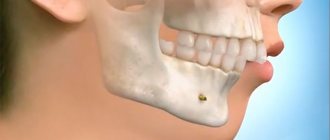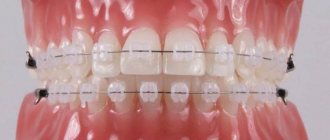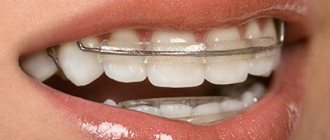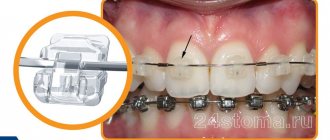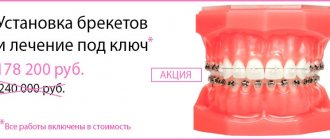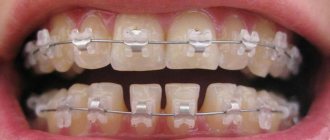- Pediatric orthodontics - correction of malocclusion in children
- Adult orthodontics - bite correction in adults
- Treatment with removable orthodontic appliances
- Correction of malocclusion without braces using mouthguards in adults.
- What orthodontic devices do our orthodontists use to correct the bite?
- How is braces treatment performed?
- What types of braces are there?
- How and why to choose an orthodontist?
- Reminder to the brace bearer
- What is orthognathy?
Do you know what awaits a patient who has braces installed? Let's find out!
Bite correction: how long does it take?
Already at the beginning of treatment, the orthodontist will tell you how long you need to wear braces - the real and maximum period of correction. The average is 1.5-2.5 years. Treatment time depends on a number of factors:
- Age of the patient - for accelerated correction, braces are placed immediately after the appearance of the main teeth of the permanent dentition.
- Bite pathology - the difficulty of correcting anomalies in the dentofacial rows directly affects the duration of treatment.
- The type and material of the orthodontic apparatus - treatment takes place differently on lingual and vestibular braces, on bracket systems made of medical sapphires, ceramics, and metal.
Oral irritation is a problem that should not be tolerated
The mouth has difficulty adjusting to braces, not only in terms of articulation, but also in terms of freedom of movement. Any staples take up space and don't allow your lips to fit as they are used to. In addition, the movement of the cheeks is slightly limited. If you feel discomfort in your cheeks or perhaps have ulcers or scratches on them, make an appointment with your dentist immediately. Most likely, the cheek is injured by the protruding arch of the bracket. The doctor should trim it or give you special wax, with which you can make the edge of the arch smooth and safe. If braces severely irritate the mucous membranes of the lips, you should consider changing them to lingual ones. They do not come into contact with the mucous membrane at all and do not cause irritation. However, before the change, you should definitely discuss your concerns with your doctor; perhaps he will recommend being patient a little longer until you adapt.
Painful sensations are everything. Ideally, any discomfort should disappear within 7-10 days. This time is enough for you to fully adapt to the new sensations in your mouth. After this, all that remains is to get used to the features of the new oral hygiene.
Braces: wearing time depending on pathologies
How long to wear braces depends directly on your bite. Orthodontists use a special classification according to Engel, where anomalies of the dentofacial rows are divided into three groups.
The first class includes minor defects. Wearing braces can restore the correct bite in 6-12 months for pathologies:
- medium-sized diastema - a gap between the front teeth;
- crowding of the front incisors - there is not enough space for the permanent teeth due to the insufficient size of the dental arch;
- trema – interdental spaces remaining after a complete change of bite;
- transposition, dystopia - tooth eruption in the wrong place.
Rodikova Tatyana
Serious bite corrections require not only correction of the position of individual teeth, but also the formation of jaw arches. That is why the process is lengthy and requires the use of rigid orthodontic arches, elastics, and numerous techniques.
Correction of a bite with the listed anomalies is quick, especially at a young age and with the correct selection of a brace system. If we compare how long a 13-year-old child needs to wear braces and an almost adult 18-year-old patient, then the speed of treatment in the first case will be higher.
Long-term wearing of braces will require pathologies belonging to the second and third classes. Among them are the types of bite:
- distal – the lower jaw is underdeveloped, and the upper jaw is too large;
- mesial – there is underdevelopment of the upper jaw with a lack of size of the lower jaw;
- open - some of the teeth do not close, which increases the load on the rest;
- deep – the lower teeth are hidden under the upper ones, completely covered by them;
- cross - the incisors cross when the upper and lower jaws meet.
Correcting the listed problems is more difficult, so wearing braces requires two to three years, followed by consolidation of the result for another 4-5 years.
Stages of defect correction and expected results
Treatment with orthodontic structures can be divided into four main stages, each of which has its own time periods:
- Leveling
. It is the first stage and lasts 4-8 months. During this period, visually noticeable changes occur - the teeth in the row become straighter. - Mechanical movement
. The longest and, at the same time, the most important of all stages of treatment takes 6-18 months. Installing more rigid arches provokes the movement of teeth forward, backward and along the axis, and also creates conditions for correcting the bite. Visually, the changes may not be noticeable as a functional transformation occurs. - Detailing
. In terms of treatment, this is the final stage, which takes 2-6 months. By this time, all movements of the teeth and jaws have been completed and all that is required is sealing the contacts between the units and detailing their position. - Consolidation of results
. The retention period is usually twice as long as the time the braces were worn. In order to consolidate the results, removable and non-removable retailers can be used.
In some particularly difficult cases, the retention period can be lifelong, that is, retailers are appointed forever. You will be able to understand how much time it will take for you to consolidate the results during the treatment process, based on data about how flexible your teeth are to shifting.
How long do you wear braces made from different materials on average?
Initial appointments with an orthodontist are devoted to many questions: how long should a teenager wear braces and how to care for them, which system to choose and which material is preferable. At this stage, doctors immediately clarify the dependence of the duration of treatment on the material and type of bracket system:
- Metal braces. The main advantage of the metal structure is the creation of optimal pressure on the teeth. This feature guarantees the correction of even the most severe malocclusions. The average time for bite correction is 12-18 months.
- Plastic braces. They have minimal strength and the lowest cost. The duration of treatment is significant, but since the design is used to eliminate minor anomalies, patients wear polymer braces for 1-1.5 years.
- Ceramic braces. The system consists of ceramic plates in the color of enamel and a metal arc. The design is aesthetically pleasing, but fragile and does not provide the necessary pressure on pathologically located units. Not suitable for correcting serious defects. The period of wearing ceramic braces is up to 3 years.
- Sapphire braces. They have an aesthetic design, are unnoticeable, and functional. They eliminate not the most complex bite defects. The course of treatment is up to 3 years.
- Lingual braces. The design involves fixation on the inside of the teeth, which allows the use of metal without compromising aesthetics. Effective, discreet - suitable for children and adult patients. The correction period is moderate - up to 2.5 years.
Rodikova Tatyana
Teenage patients pay increased attention to aesthetics, which is why they choose ceramic braces. Metal ones are also popular, especially due to the ability to put colored rubber bands and thus express oneself.
Comparison of brace systems by duration of wearing
It is difficult to estimate the duration of wearing braces in absolute numbers. Doctors recommend systems taking into account the patient’s age and the complexity of the pathology - they select designs with a moderate duration of wear. But if you choose similar solutions to eliminate the same defect, where the duration of the correction will be shorter:
- Material. Metal is the preferred option and guarantees quick correction. In second place are ceramics, then sapphire braces and plastic ones.
- Place of fixation. Lingual braces are more effective than vestibular braces, but the latter are more comfortable to wear and more affordable.
- Ligature or self-ligating - from vestibular brace systems. Elastic ligatures help set the vector of maximum impact and provide the best point pressure on a tooth or a specific area. This strategy shortens treatment.
Lisp is an unpleasant moment at the very beginning
The first thing that clients of dental clinics complain about is the loss of clarity of sounds when speaking. Let's face it, this is awkward. You can feel like a very small child who is about to be taken to a speech therapist. Immediately after installing braces, speech becomes lisping and all voiced sounds disappear. But you shouldn’t be particularly afraid of this - the defect will go away in a few days when you get used to articulating, taking into account the additional structure in your mouth. If you are very confused, you can do the installation on Friday, and then over the weekend your speech will become more or less clear. Full recovery usually takes at least a week. But then there are no problems with this anymore.
How long do teenagers wear braces?
The standard age for installing braces is 12-17 years. The physiology of the child’s body makes the speed of bite correction faster and the treatment more effective. The following factors contribute to reducing the period of wearing braces:
- complete change of bite;
- eruption of second molars;
- the end of the formation of the dental system and the muscular-ligamentous apparatus while maintaining their good mobility.
The bone tissue of adolescents is plastic and quickly responds to mechanical pressure, which allows teeth to be shifted to an anatomically correct position.
Soldatenkova Alina
I am often asked how long to wear braces for a 13-year-old teenager. The average time for bite correction is 1-1.5 years. But each case is individual.
Can you continue to live with crooked teeth?
Crooked teeth are more vulnerable to tooth decay and periodontal disease. If teeth grow incorrectly, their surfaces become excessively worn down when eating, which worsens the malocclusion. Therefore, sometimes it leads to serious diseases of the temporomandibular joints.
In addition, if you suffer from frequent headaches, chondrosis, or have tinnitus, it is better to check your bite.
Wearing braces: average time, minimum, maximum
Children's orthodontists have long collected statistics on how long it takes from fixation to removal of braces:
- quick treatment – six months to a year;
- the average for severe anomalies is 1-2.5 years;
- the maximum period (registered record) is more than 9 years.
Every year the complexity and duration of treatment increases. Correcting the same pathology at 27 years old will require almost a year more time than at 18 years old.
How to speed up treatment with braces
All patients can delay the time of braces removal. To do this, you must comply with the requirements of the pediatric orthodontist:
- Come to scheduled appointments. An appointment is more than just an examination. When communicating with the patient, the doctor evaluates the dynamics, changes ligatures and arches, and selects elastics for enhanced correction.
- Monitor the integrity of the system. If the ligatures break, the bracket comes off, or the orthodontic arch falls out, the patient needs to urgently consult a doctor to restore the structure.
- Change elastics according to schedule. At a certain stage of correction, the orthodontist strengthens the work of braces with the help of elastic bands. At home, the patient must change elastics every 12 hours - independently and without skipping.
Wearing braces is an effective way to correct the position of teeth and bite characteristics. Following the orthodontist's recommendations will help you get rid of crooked teeth, protruding or receding jaws - make your teeth straight and beautiful.
Removing braces - don't forget about care
We know that you will most likely immediately want to show off your smile to everyone. But! It is too early. After your braces are removed, you will need to wear retainers. These are special staples (much smaller than the previous ones) that prevent bone tissue from returning to its original place. Retainers are:
- Removable (alignments and plates), they are often used to correct bites in children when the jaw is still very plastic. These retainers are worn at night and do not need to be worn during the day. 24-hour wearing is recommended only in rare cases when the installation of a permanent retainer causes great discomfort in care.
- Permanent retainers. They are attached to the teeth from the inside, so they are not visible. Such models cannot be removed independently, so they are worn around the clock. However, you need to make sure that the retainer does not come off and tightens the teeth tightly. If it becomes loose, visit a doctor as soon as possible, because there will be no benefit from wearing such a system.
Taking care of your oral cavity with retainers is much easier. Especially if you choose a removable model. It is enough to rinse it in a special disinfectant solution and hide it in a case for a day. As for fixed retainers, to clean them you should leave the brush that you previously used with braces.
How long you will have to wear retainers is a difficult question. Sometimes this is a temporary solution until the jaw is firmly fixed in its new position. Sometimes you have to wear them almost all your life to maintain the correct bite. This usually happens when teeth are corrected in adults after 30 years of age. So, yes, the discomfort may linger. Although you quickly get used to it. In addition, retainers, like braces, require careful oral care, which has a positive effect on the condition of your teeth.



